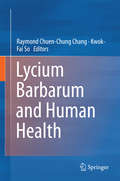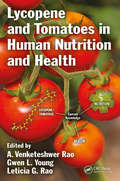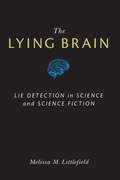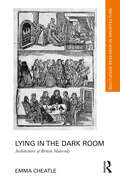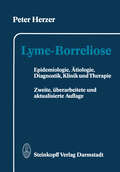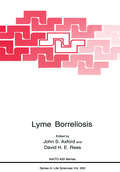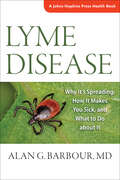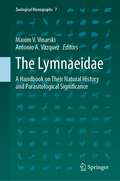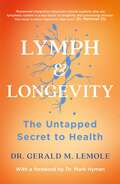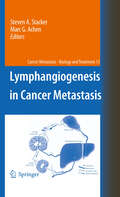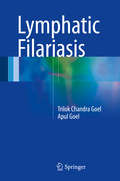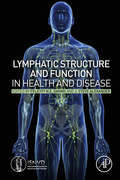- Table View
- List View
Luxury Online: Styles, Systems, Strategies
by Uché OkonkwoThis new book focuses on the analysis of the online strategy and development of the luxury industry, tracing the evolution of the Internet from a means of communication to a trade and distribution channel. The author provides a comprehensive evaluation and a critical assessment of the tactics required for the management of luxury brands online.
Lycium Barbarum and Human Health
by Raymond Chuen-Chung Chang Kwok-Fai SoThis book seeks to unravel the mysteries of wolfberry, and systematically introduces its mechanisms in preventing aging-associated diseases, such as cardiovascular diseases, inflammation, liver and neurodegenerative diseases. Wolfberry, the dried fruit of Lycium barbarum, is an anti-aging herbal medicine. There have been numerous reports investigating the underlying mechanisms of its anti-aging effects and its role in preventing pathological changes in many aging-associated diseases. Its holistic effects on the body can attenuate liver toxicity and combat the spread of cancer; it also prevents degeneration in the central nervous system, and can even positively affect the skin. As such, wolfberry has become a very popular food supplement around the world. This book will serve as an excellent reference source for researchers and graduate students studying herbal medicine and aging-associated diseases, while also providing insights for the pharmaceutical industry with regard to developing potential drugs for these diseases.
Lycopene and Tomatoes in Human Nutrition and Health
by A. Venketeshwer Rao Gwen L. Young Leticia G. RaoLycopene is a potent antioxidant carotenoid found in fruits and vegetables; particularly high amounts exist in red tomatoes. It is not an essential nutrient for humans, but can be a potential therapeutic agent for preventing several human diseases. Since the publication of the previous book on lycopene, extensive advances have been made with respect to the role of lycopene and tomatoes in human health. Whereas the initial focus of research was on cancer, Lycopene and Tomatoes in Human Nutrition and Health represents the next major step in documenting advances in understanding the chemistry, bioavailability, metabolism; mechanisms of action of lycopene; and its role in preventing human diseases other than cancer as discussed in the various chapters of the book. The book includes chapters that discuss genetic polymorphisms; and lycopene’s relationship to cardiovascular diseases, cardiometabolic diseases, bone health, and other health disorders including male infertility, skin diseases, respiratory disorders and neurodegenerative diseases. The book includes information addressing regulatory aspects of natural health products and, in particular lycopene, presenting industrial insights. The contents of the book are selected carefully to provide the readers with the most current information available on lycopene and tomato bioactives.
Lycopene and Tomatoes in Human Nutrition and Health
by A. Venketeshwer Rao Gwen L. Young Leticia G. RaoLycopene is a potent antioxidant carotenoid found in fruits and vegetables; particularly high amounts exist in red tomatoes. It is not an essential nutrient for humans, but can be a potential therapeutic agent for preventing several human diseases. Since the publication of the previous book on lycopene, extensive advances have been made with respect to the role of lycopene and tomatoes in human health. Whereas the initial focus of research was on cancer, Lycopene and Tomatoes in Human Nutrition and Health represents the next major step in documenting advances in understanding the chemistry, bioavailability, metabolism; mechanisms of action of lycopene; and its role in preventing human diseases other than cancer as discussed in the various chapters of the book. The book includes chapters that discuss genetic polymorphisms; and lycopene’s relationship to cardiovascular diseases, cardiometabolic diseases, bone health, and other health disorders including male infertility, skin diseases, respiratory disorders and neurodegenerative diseases. The book includes information addressing regulatory aspects of natural health products and, in particular lycopene, presenting industrial insights. The contents of the book are selected carefully to provide the readers with the most current information available on lycopene and tomato bioactives.
The Lying Brain: Lie Detection in Science and Science Fiction
by Melissa M Littlefield"The Lying Brain is a study to take seriously. Its argument is timely, clear, and of particular importance to the enlargement of our understanding of the relationships among science studies, literary studies, and technology studies." ---Ronald Schleifer, University of Oklahoma Real and imagined machines, including mental microscopes, thought translators, and polygraphs, have long promised to detect deception in human beings. Now, via fMRI and EEG, neuroscientists seem to have found what scientists, lawyers, and law enforcement officials have sought for over a century: foolproof lie detection. But are these new lie detection technologies any different from their predecessors? The Lying Brain is the first book to explore the cultural history of an array of lie detection technologies: their ideological assumptions, the scientific and fictional literatures that create and market them, and the literacies required for their interpretation. By examining a rich archive of materials about lie detection---from science to science fiction---The Lying Brain demonstrates the interconnections of science, literature, and popular culture in the development and dissemination of deception detection in the American cultural imagination. As Melissa Littlefield demonstrates, neuroscience is not building a more accurate lie detector; it is simply recycling centuries-old ideologies about deception and its detection. Cover art: "Human Brain" © Denis Barbulet, courtesy of Shutterstock.com
Lying in the Dark Room: Architectures of British Maternity (Routledge Research in Architecture)
by Emma CheatleLying in the Dark Room: Architectures of British Maternity returns to and reflects on the spatial and architectural experience of childbirth, through both a critical history of maternity spaces and a creative exploration of those we use today. Where conventional architectural histories objectify buildings (in parallel with the objectification of the maternal body), the book—in the mode of creative practice research—presents a creative-critical autotheory of the architecture of lying-in. It uses feminist, subjective modes of thinking that travel across disciplines, registers and arguments. The book assesses the transformation of maternity spaces—from the female bedchamber of seventeenth- and eighteenth-century marital homes, to the lying-in hospitals of the eighteenth and nineteenth centuries purposely built by man-midwives, to the late twentieth-century spaces of home and the modern hospital maternity wing—and the parallel shifts in maternal practices. The spaces are not treated as mute or neutral backdrops to maternal history but as a series of vital, entangled atmospheres, materials, practices and objects that are produced by, and, in turn, produce particular social and political conditions, gendered structures and experiences. Moving across spaces, systems, protagonists and their subjectivities, the book shows how hospital design and protocol altered ordinary birth at home and continues to shape maternal spatial experience today. As such, it will be of interest to a wide range of readers, from architectural historians, theoreticians, designers and students to medical humanities historians, to English Literature, humanities and material studies scholars, as well as those interested in creative-critical writing.
Lying in the Dark Room: Architectures of British Maternity (Routledge Research in Architecture)
by Emma CheatleLying in the Dark Room: Architectures of British Maternity returns to and reflects on the spatial and architectural experience of childbirth, through both a critical history of maternity spaces and a creative exploration of those we use today. Where conventional architectural histories objectify buildings (in parallel with the objectification of the maternal body), the book—in the mode of creative practice research—presents a creative-critical autotheory of the architecture of lying-in. It uses feminist, subjective modes of thinking that travel across disciplines, registers and arguments. The book assesses the transformation of maternity spaces—from the female bedchamber of seventeenth- and eighteenth-century marital homes, to the lying-in hospitals of the eighteenth and nineteenth centuries purposely built by man-midwives, to the late twentieth-century spaces of home and the modern hospital maternity wing—and the parallel shifts in maternal practices. The spaces are not treated as mute or neutral backdrops to maternal history but as a series of vital, entangled atmospheres, materials, practices and objects that are produced by, and, in turn, produce particular social and political conditions, gendered structures and experiences. Moving across spaces, systems, protagonists and their subjectivities, the book shows how hospital design and protocol altered ordinary birth at home and continues to shape maternal spatial experience today. As such, it will be of interest to a wide range of readers, from architectural historians, theoreticians, designers and students to medical humanities historians, to English Literature, humanities and material studies scholars, as well as those interested in creative-critical writing.
Lyme Borreliosis (Nato Science Series A: #260)
by John S. Axford David H. E. ReesLyme Borreliosis is a worldwide infectious disease causing a multisystem illness with considerable morbidity, particularly in North America and Europe. The causative agent is the spirochaete Borrelia burgdorferi, which is usually transmitted by the ixodid tick from animal reservoirs. This book is formed by contributions from the Second European Symposium on Lyme Borreliosis, held at St George's Hospital Medical School, London in 1993, which reviewed the current state of knowledge of the condition with regard to clinical manifestations, diagnosis, treatment, ecology, epidemiology, biology and immunopathogenesis. In this book, important data is reviewed concerning the clinical manifestations of Lyme Borreliosis. It seems that strain variation of the spirochaete is the main cause of regional differences seen in the clinical presentation of patients. One striking example of this, is the relatively high incidence of Lyme arthritis in the USA and apparent rarity of this manifestion in some areas of Europe. These important studies open the way for exciting new research that focuses on the immunological and molecular mechanisms that result in disease. A full insight into the ecology of Borrelia burgdorferi is essential to a balanced understanding of the disease and a number of excellent reviews on this subject are included. Significant advances with regard to the biology of Borrelia burgdorjeri and the immunopathogenic mechanisms that result in disease have been made, enabling the role of the Band T lymphocytes in disease to be established and the development of sophisticated phenotyping methods, improved diagnostic tests and effective vaccines.
Lyme Borreliosis
by Klaus-Peter Hunfeld Jeremy GrayThis book is a compact clinical introduction to Lyme borreliosis for physicians of all specialties who care for patients with suspected B. burgdorferi infection, whether in hospital or general practice. The book provides a great deal of practice-oriented information on symptomatology, diagnosis, treatment, and prophylaxis with a special emphasis on the situation in Europe. At the same time, it describes contemporary scientific knowledge in as much detail as is required in order to understand the pathogenetic relationships and their relevance to medical care. The authors are members of an interdisciplinary expert group of epidemiologists, biologists, microbiologists, and clinicians who have been working in the area of tick-borne diseases for many years. The personal experience of each of the authors, accumulated through their daily work with patients in special clinics or by confrontation with complicated questions in basic research, epidemiology, and laboratory diagnostics of Lyme borreliosis, represents an important mainstay of the book. Written from the perspective of clinical management and practical problem-solving, this topical monograph will assist clinicians in meeting diagnostic challenges and providing appropriate medical aid to patients with Lyme borreliosis.
Lyme Borreliosis in Europe and North America: Epidemiology and Clinical Practice
by Sunil K. SoodThe facts about Lyme disease, from epidemiology to treatment to control Lyme borreliosis, popularly known as Lyme disease, remains the most commonly reported tick-transmitted infection in North America and Europe. A growing body of scientific and clinical evidence has facilitated early diagnosis and effective treatment. Nonetheless, there are a number of misconceptions about this infectious disease that have given rise to unproven, potentially dangerous alternative therapies. In Lyme Borreliosis in Europe and North America, a team of authors whose expertise spans basic research, epidemiology, and clinical practice has compiled evidence-based information on Lyme borreliosis. Presents all the latest evidence needed to diagnose, treat, and prevent Lyme disease Lyme Borreliosis in Europe and North America begins with a review of the disease's epidemiology, the causative Borrelia genospecies, and tick vectors. It then explores pathogenesis, diagnosis, and treatment. Next, the book examines the role of serologic, culture, and molecular diagnostic methods. The book also features a chapter on prognosis, offering an evidence-based review of outcome studies, as well as practical advice to physicians to help them manage the challenging clinical scenario of chronic symptoms attributed to Borrelia infection. The final chapter is a guide to prevention strategies, including the management of tick bites. Examines similarities and differences in Europe and North America Because differences in Borrelia genospecies are responsible for differences in the clinical presentation of Lyme borreliosis between North America and Europe, this book provides descriptions of the disease as it presents on each continent. Most of the chapters have been cowritten by experts on each continent, in order to provide a balanced perspective that combines European and North American findings, practices, and experiences. Helps everyone better understand, treat, and control Lyme disease Lyme Borreliosis in Europe and North America is a comprehensive reference, ideal for clinicians, researchers, and public health officials who seek to treat and control Lyme borreliosis. It will help them better understand the facts and make sense of the misconceptions and myths that surround this infectious disease.
Lyme Carditis: From A to Z
by Adrian Baranchuk Rachel Wamboldt Chang Nancy WangThis book provides valuable tools for the appropriate diagnosis and management of Lyme carditis. It includes epidemiological, pathophysiological and clinical recommendations for the identification, confirmation and management of the disease. With one score that currently facilitates diagnosing Lyme carditis when patients present with undiagnosed complete heart block (the “SILC Score”), a rapid recognition of Lyme carditis as the cause of conduction disorders is essential to allow early treatment with IV antibiotics with a high probability of complete resolution and avoiding unnecessary pacemaker implantation. Lyme carditis: From A to Z provides a clinical algorithm to facilitate management, pre-discharge evaluations of the conduction system and long-term follow-up of patients properly treated for Lyme carditis. It provides a proven approach to patients implanted with cardiac devices and in whom Lyme carditis is subsequently diagnosed, while it also explores the possibility of Lyme dilated cardiomyopathy as a chronic manifestation of Lyme disease. This book therefore represents an original and unique resource that sheds light on an important topic of discussion in many endemic regions of the world.
Lyme Disease: An Evidence-based Approach
by Paul G Auwaerter Phillip Baker Alan G Barbour Dag Berildda Raymond J Dattwyler Rick Dersch David M Dudzinski Randi Eikeland Afton L. Hassett Linden Hu Adriana Marques Paul S Mead Robert B Nadelman Erlend Roaldsnes Jonathan R Salik Eugene D Shapiro Lenard Sigal Robert Smith Kirk Sperber Gerold Stanek Franc Strle Klemen Strle Gary WormserThis new edition of Lyme Disease provides up-to-date evidence-based research and covers the significant advances in our understanding of the disorders referred to as Lyme disease or Lyme borreliosis. This book explores the causative organism, its requisite ecosystem, disease epidemiology, host-Borrelia interactions, diagnostic testing, clinical manifestations, therapeutic options, the role of host immunity on pathogenesis and long term prognosis. The authors provide balanced perspectives on all aspects of Lyme disease and explicitly review both the basic biology of the infection and practical clinical aspects. This new edition: Includes new borrelial pathogens that have been identified (B. miyamotoi, B. mayonii and B. bavariensis among others). Provides updated information on the molecular biology of the organism, neuroborreliosis, and the role of the C6 peptide in diagnosis. Discusses the controversies about 'chronic Lyme disease', post Lyme disease syndrome and other ongoing but non-specific symptoms that have been attributed to this infection. As the endemic footprint of Lyme disease continues to grow, this book provides a broad and detailed guide for clinicians and researchers involved with the diagnosis and treatment of the condition. Covering biology, epidemiology and therapeutics, it is also essential reading for students of global health and infectious disease.
Lyme Disease: Why It’s Spreading, How It Makes You Sick, and What to Do about It (A Johns Hopkins Press Health Book)
by Alan G. BarbourOnce restricted to small forested areas in the northeast and north-central United States, Lyme disease is now a common infection in North America and Europe. The Centers for Disease Control and Prevention estimate that more than 300,000 new cases occur each year in the United States. Misunderstandings over symptoms and treatment increase the public's concerns about the disease�which, if not properly treated, can become chronic and debilitating. An expert on tick-borne diseases, Alan G. Barbour explains the course of illness that results from infection, diagnosis and treatment options, and steps that can be taken to avoid a tick bite in the first place. The ticks that transmit Lyme disease may also transmit other disease-causing pathogens, and these other infections are considered as well. Drawing on real case histories of individuals with Lyme disease�or illnesses that may be mistaken for Lyme disease�Barbour explains: The biology of the spirochete, Borrelia burgdorferi, that causes Lyme disease The role of animals such as mice that carry the infection The life cycle of the ticks that transmit the infection The importance of deer in perpetuating the cycle The basics of diagnostic laboratory tests and how test results are interpreted How antibiotics are used in treating Lyme diseaseInfected ticks are abundant in the woods, in walking trails, and in the shrubs and tall grass where suburban lawns meet wooded areas. Barbour stresses preventing disease through community-wide ecology projects and individual and household protection. While it may be difficult to escape infection, understanding the danger, the symptoms, and the treatment goes a long way toward preventing long-term health consequences. Featuring a list of reliable web sites and a glossary of terms, Lyme Disease is an invaluable resource for everyone who is at risk of the disease or is involved in preventing and treating it.
The Lymnaeidae: A Handbook on Their Natural History and Parasitological Significance (Zoological Monographs #7)
by Maxim V. Vinarski Antonio A. VázquezThe Lymnaeidae (also known as ‘pond snails’) are a species-rich and globally distributed family of freshwater snails, many species of which are known to be hosts of parasitic trematodes (such as the liver fluke, Fasciola hepatica). Written by world-leading experts in the field, this book covers a wealth of topics ranging from the phylogeny and taxonomy of lymnaeid snails to their relationships with helminths and their impact on public and veterinary health. It provides an overview of the species richness, evolution, ecology, biogeography and fossil record of the family. A considerable number of chapters are devoted to the economic and medical importance of lymnaeids, their involvement in the transmission of fascioliasis and other zoonotic diseases. Special chapters deal with the molecular and morphological identification of the Lymnaeidae, their rearing in the laboratory and experimental approaches to their study. This contributed volume is aimed at experts and practitioners in various disciplines: Invertebrate zoology, evolutionary biology, biogeography, aquatic ecology, parasitology, epidemiology and public health. It is also useful for university lecturers, undergraduate and postgraduate students.
LYMPH & LONGEVITY: The Untapped Secret to Health
by Dr Gerald M LemoleThe lymphatic system has been one of the most misunderstood systems in our bodies. Until now.Cardiothoracic surgeon Dr. Gerald M. Lemole explains why a healthy lymphatic flow aids our bodies in reducing toxins that contribute to disease and injury. In ten short chapters, Dr. Lemole demystifies the lymphatic system, describes how powerful it is and shows how to maintain a healthy lymph system to combat specific diseases and health problems - from heart disease to cognitive function to weight management.Featuring sidebars with charts and graphs that illustrate basic principles, Lymph & Longevity also includes menus, recipes and information on supplements, as well as basic yoga and meditation guides.Illuminating, informative, and practical this essential guide is timelier now than ever as we continue to work to protect ourselves and our communities against COVID-19 and other viruses.
Lymph Node Cytopathology (Essentials in Cytopathology #10)
by Stefan E. Pambuccian Ricardo H. BardalesThis volume in the Essentials in Cytopathology book series will focus on the cytopathology of lymph nodes. It will address the topic of fine needle aspiration of lymph nodes and fulfill the need for an easy-to-use and authoritative synopsis of lymph node cytopathology. The book with adopt an algorithmic diagnostic approach, starting from the cytomorphologic pattern of the lymph node aspirate. The focus will be on the appropriate and effective use of ancillary studies (immunohistochemistry, flow cytometry, fluorescence in situ hybridization and molecular techniques) and integration of their results into the final diagnosis. The book will present the cytopathologic features and differential diagnoses for the major cytologic patterns in lymph node fine needle aspiration. The entities typically falling within each of these patterns will be discussed with illustration of the spectrum of cytologic features, differential diagnoses and pitfalls. The book will cover the full spectrum of benign and malignant primary conditions of the lymph nodes, with emphasis on common disorders. Discussion of metastatic conditions will be restricted to those that are relevant to the differential diagnosis of primary lymphoid disorders. This book is designed as an easy to use resource that fits into the lab coat pocket, ideal for portability and quick reference. It is heavily illustrated and contains useful algorithms that guide the reader through the differential diagnosis of common and uncommon entities encountered in lymph node aspirates. The accompanying text follows an easy to use pattern-based outline. A useful resource for every pathologist, cytopathologist, fellow and trainee.
Lymph Node Metastasis in Gastrointestinal Cancer
by Shoji NatsugoeThis book provides the most comprehensive and up-to-date knowledge of lymph node micrometastasis (LMM) and sentinel node navigation surgery (SNNS) in gastrointestinal cancers. Lymph node metastasis is a critically important prognostic factor in gastrointestinal tract cancers such as tumors of the esophagus, stomach, and colorectum. An understanding of the basic aspects of lymphatics and lymph nodes, including anatomy, histology, physiology, immunology, and molecular biology, is fundamental for physicians who are involved in cancer treatment. Furthermore, owing to the development of molecular and biological methodology, the precise recognition of LMM and its clinical significance have been clarified recently. At the same time, SNNS has actually been anticipated in treatment of breast tumors, and it is now being introduced in gastrointestinal tract cancer. For the application of SNNS, the detection of lymph node metastasis including LMM is extremely significant, because the presence of LMM determines the direction for surgery and chemo and/or radiation therapy. With these considerations in mind, the expert contributors to this book review basic and clinical approaches for LMM and SNNS including methodology for gastrointestinal cancers. Thus this volume benefits not only surgeons who treat gastrointestinal cancers but also clinical oncologists and medical scientists such as physiologists and pathologists.
Lymph Node Pathology for Clinicians (Pathology for Clinicians)
by Michel R. Nasr Anamarija M. Perry Pamela SkrabekLymph node pathology is a complex and rapidly evolving field that requires integration of morphologic findings with a number of ancillary studies, as well as clinical information, to diagnose neoplastic and non-neoplastic hematopoietic disorders. Lymphomas are currently classified according to the 2016 Revision of the World Health Organization (WHO) Classification, which emphasizes, and for some diagnoses mandates, the integration of clinical information in diagnostic decision making. Successful collaboration and teamwork between pathology and clinical specialties (especially hematology/oncology) are paramount for excellent patient care. In addition to diagnosis, pathology plays a significant role in lymphoma prognostication and therefore contributes to patient’s management and follow-up. Lymph Node Pathology for Clinicians provides a concise overview of different entities in lymph node pathology with the primary audience being clinicians. Not all entities are covered, but, rather, the most common and/or clinically most relevant ones were included. This text is intended as a quick reference for a clinician to become familiar with pathologic aspects of lymphomas and the thought process of a pathologist. Particular consideration is given to relevant diagnostic and prognostic ancillary studies. Organized with an interdisciplinary approach for effective management of lymph node disorders, this text aims to educate our clinical colleagues on the most important aspects of lymph node pathology.
Lymphangiogenesis in Cancer Metastasis (Cancer Metastasis - Biology and Treatment #13)
by Steven A. Stacker Marc G. AchenLymphangiogenesis and Cancer Metastasis introduces the new field of lymphatic vessel growth and development, and its relationship to the metastatic spread of cancer cells. The book covers all aspects of this new field from the fundamental role that protein growth factors and their receptors play in lymphangiogenesis to the potential application of these advances to cancer diagnosis and treatment. Other clinical aspects explored include the mechanisms and importance of lymph node metastasis, the role of the lymphatics in lymphangioleiomyomatosis and Kaposi’s sarcoma, and approaches for imaging lymphatics in cancer. The book also covers the innovative approaches taken by researchers to explore new roles for lymphatic vessel biology in the context of cancer. The information presented in this volume, which describes the revolutionary concepts of tumor lymphangiogenesis, will be of interest to all students, scientists and oncologists who are seeking to understand the complexities of tumor metastasis. Key Features: Presents fundamental concepts of tumor lymphangiogenesis and the molecules which control this process Provides a comprehensive summary of current research in this ground breaking area Provides a book which links progress in basic tumor and developmental biology with current and future oncology practise Is an essential text for molecular biologists, cell biologists and oncologists seeking to understand the implications of this rapidly developing area.
Lymphatic Filariasis
by Trilok Chandra Goel Apul GoelThis book provides up-to-date information on lymphatic filariasis supported with abundant images, tables and algorithms. It is a first such monograph on a disease that has varied presentations which are complete clinical entities, such as chyluria, hydrocele, elephantiasis, etc. This book consists of three parts, parasitology, acute clinical manifestations and chronic presentations of the disease. Approximately 120 million people are infected with lymphatic filariasis in tropical and subtropical countries. About a third of these suffer clinical consequences of this infection, and many are seriously disfigured. India, Indonesia and Nigeria are the most endemic countries in the world. In spite of Global Control Program of WHO, filariasis continues to be a significant medical challenge and current efforts underway will take a long time to bring it under control. Lymphatic Filariasis is meant for general surgeons, physicians, urologists and plastic surgeons, including the postgraduate students. Useful for epidemiologists, internists, and those involved in filariasis prevention programs.
Lymphatic Filariasis: Epidemiology, Treatment and Prevention - The Indian Perspective
by Brij Kishore TyagiLymphatic Filariasis (LF) is a group of human and animal infectious diseases caused by nematode parasites of the order Filariidae. Often neglected, it is one of the oldest and the most debilitating tropical diseases (NTDs), transmitted from human to human by mosquitoes bites, particularly the brown black mosquito known as Culex quinquifasciatus. LF is a major public health problem in many parts of the tropics, especially India, which accounts for as much as 40% of total global cases. As a leading cause of permanent and long-term disability worldwide, the parasite infection imposes a severe physical and socioeconomic burden. The World Health Organization (WHO) estimates that 1.4 billion people live in high-risk areas – 120 million of which are already infected with LF, including 22 million children below the age of 15 and about 76 million who suffer from damaged lymphatic and renal systems.India has made great strides toward eliminating the disease, and these advances are of global significance. They include early diagnosis mechanisms, vaccine product development, detection of parasites in the vector, and studies on parasite evolution trends in nature as warning signals. Reports on the successes and failures are needed to enable measures to be taken to avoid disaster and ensure a smooth transition from endemicity in India to the elimination of lymphatic filariasis by 2020. This book, which gathers highly original contributions on various subjects related to lymphatic filariasis, discusses the latest scientific research that will help the nation to achieve this milestone. It also serves as a guide to many other countries struggling against this highly debilitating and incapacitating disease.
Lymphatic Metastasis and Sentinel Lymphonodectomy (Recent Results in Cancer Research #157)
by Peter M. Schlag Umberto VeronesiMetastases determine malignancy. The main attention so far has been focused upon organ metastases. The molecular mechanisms thereof, while far from being totally elucidated, are increasingly well understood. Modern diagnostic tools now enable detection and precise localization of small lesions. In contrast, our knowl edge and diagnostic capabilities regarding metastatic spread to the'lymphatic system are rather limited. However, there have re cently been a number of interesting advances. It is the aim of this volume to submit these developments to detailed analysis. The therapeutic relevance of enhanced sensitivity in detection of lymph node metastases has to be considered in the light of in creased morbidity versus eventual prognostic improvements by modification of therapy. An interesting concept which might im prove diagnostic accuracy while reducing operative morbidity is the "sentinel node" technique. Surgical standards are lacking, however, and many fundamental questions pertaining to precise lymphatic mapping remain unanswered. Whether the sentinel node concept is of general relevance or whether it is applicable in only a few organs remains to be determined. This book offers intensive discussion of the concept from methodological and tu mor biological viewpoints. World-renowned experts with long term involvement in related basic and clinical research provide the reader with a broad survey of actual knowledge together with a critical appraisal of recent and future developments. We sincerely hope this book succeeds in providing an outlook as a reference for all clinicians on future prospects and serving and researchers in this extremely important field.
Lymphatic Structure and Function in Health and Disease
by Felicity N.E. Gavins J. Steve AlexanderLymphatic Structure and Function in Health and Disease serves as a resource book on what has been learned about lymphatic structure, function and anatomy within different organ systems. This is the first book to bring together lymphatic medicine as a whole, with in-depth analysis of specific aspects of lymphatics in different vascular pathologies. This book is a useful tool for scientists, practicing clinicians and residents, in particular, those in vascular biology, neurology, cardiology and general medicine. Chapters discuss topics such as ontogeny and phylogeny of lymphatics, lymphatic pumping, CNS lymphatics, lymphatics in transplant and lymphatic reconstruction.Brings together lymphatic medicine as a whole, with an in-depth analysis of the specific basic science aspects of lymphatic structure and functionCovers the clinical aspects of lymphatics in different vascular pathologiesCo-published with the International Society of Neurovascular DiseasesDiscusses lymphatic structure and function in all of the major organ systems

